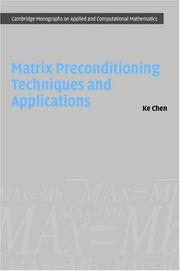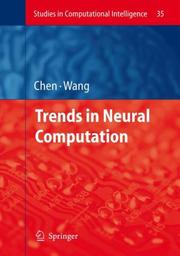| Listing 1 - 10 of 36 | << page >> |
Sort by
|

ISBN: 0521838282 9780521838283 9780511543258 051111558X 9780511115585 0511115032 9780511115035 0511543255 1107150590 9781107150591 1280434805 9781280434808 9786610434800 6610434808 0511181930 9780511181931 051119904X 051129980X Year: 2005 Volume: 19 Publisher: Cambridge ; New York : Cambridge University Press,
Abstract | Keywords | Export | Availability | Bookmark
 Loading...
Loading...Choose an application
- Reference Manager
- EndNote
- RefWorks (Direct export to RefWorks)
Preconditioning techniques have emerged as an essential part of successful and efficient iterative solutions of matrices. Ke Chen's book offers a comprehensive introduction to these methods. A vast range of explicit and implicit sparse preconditioners are covered, including the conjugate gradient, multi-level and fast multi-pole methods, matrix and operator splitting, fast Fourier and wavelet transforms, incomplete LU and domain decomposition, Schur complements and approximate inverses. In addition, aspects of parallel realization using the MPI are discussed. Very much a users-guide, the book provides insight to the use of these techniques in areas such as acoustic wave scattering, image restoration and bifurcation problems in electrical power stations. Supporting MATLAB files are available from the Web to support and develop readers' understanding, and provide stimulus for further study. Pitched at graduate level, the book is intended to serve as a useful guide and reference for students, computational practitioners, engineers and researchers alike.
Matrices --- Differential equations --- Iterative methods (Mathematics) --- Integral equations --- Sparse matrices --- Equations différentielles --- Itération (Mathématiques) --- Equations intégrales --- Matrices éparses --- Numerical solutions --- Data processing --- Solutions numériques --- Informatique --- data processing --- Spare matrix techniques --- Equations, Integral --- Functional equations --- Functional analysis --- Iteration (Mathematics) --- Numerical analysis --- Data processing. --- 517.91 Differential equations --- Equations différentielles --- Itération (Mathématiques) --- Equations intégrales --- Matrices éparses --- Solutions numériques --- 517.91 --- Numerical solutions&delete& --- Sparse matrices - data processing --- Differential equations - Numerical solutions - Data processing --- Iterative methods (Mathematics) - Data processing --- Integral equations - Numerical solutions - Data processing
Book
ISBN: 3030986616 Year: 2023 Publisher: Cham : Springer International Publishing : Imprint: Springer,
Abstract | Keywords | Export | Availability | Bookmark
 Loading...
Loading...Choose an application
- Reference Manager
- EndNote
- RefWorks (Direct export to RefWorks)
This handbook gathers together the state of the art on mathematical models and algorithms for imaging and vision. Its emphasis lies on rigorous mathematical methods, which represent the optimal solutions to a class of imaging and vision problems, and on effective algorithms, which are necessary for the methods to be translated to practical use in various applications. Viewing discrete images as data sampled from functional surfaces enables the use of advanced tools from calculus, functions and calculus of variations, and nonlinear optimization, and provides the basis of high-resolution imaging through geometry and variational models. Besides, optimization naturally connects traditional model-driven approaches to the emerging data-driven approaches of machine and deep learning. No other framework can provide comparable accuracy and precision to imaging and vision. Written by leading researchers in imaging and vision, the chapters in this handbook all start with gentle introductions, which make this work accessible to graduate students. For newcomers to the field, the book provides a comprehensive and fast-track introduction to the content, to save time and get on with tackling new and emerging challenges. For researchers, exposure to the state of the art of research works leads to an overall view of the entire field so as to guide new research directions and avoid pitfalls in moving the field forward and looking into the next decades of imaging and information services. This work can greatly benefit graduate students, researchers, and practitioners in imaging and vision; applied mathematicians; medical imagers; engineers; and computer scientists.
Mathematical models. --- Computer vision. --- Mathematical optimization. --- Optimization (Mathematics) --- Optimization techniques --- Optimization theory --- Systems optimization --- Mathematical analysis --- Maxima and minima --- Operations research --- Simulation methods --- System analysis --- Machine vision --- Vision, Computer --- Artificial intelligence --- Image processing --- Pattern recognition systems --- Models, Mathematical --- Mathematics --- Mathematical analysis. --- Neural networks (Computer science). --- Computational Mathematics and Numerical Analysis. --- Computer Imaging, Vision, Pattern Recognition and Graphics. --- Optimization. --- Analysis. --- Mathematical Models of Cognitive Processes and Neural Networks. --- Data processing. --- Digital techniques. --- Artificial neural networks --- Nets, Neural (Computer science) --- Networks, Neural (Computer science) --- Neural nets (Computer science) --- Natural computation --- Soft computing --- 517.1 Mathematical analysis --- Digital image processing --- Digital electronics --- Models matemàtics --- Visió per ordinador --- Diagnòstic per la imatge --- Optimització matemàtica --- Neural networks (Computer science)
Book
ISBN: 9789041133014 Year: 2011 Publisher: Alphen aan den Rijn : Kluwer International,
Abstract | Keywords | Export | Availability | Bookmark
 Loading...
Loading...Choose an application
- Reference Manager
- EndNote
- RefWorks (Direct export to RefWorks)
Labor laws and legislation --- Industrial relations --- Travail --- Relations industrielles --- Droit
Book
ISBN: 9403529423 9403529415 Year: 2020 Publisher: Alphen aan den Rijn, The Netherlands : Wolters Kluwer,
Abstract | Keywords | Export | Availability | Bookmark
 Loading...
Loading...Choose an application
- Reference Manager
- EndNote
- RefWorks (Direct export to RefWorks)

ISSN: 1860949X ISBN: 9783540361213 3540361219 9786610700776 1280700777 3540361227 Year: 2006 Volume: v. 35 Publisher: Berlin, Germany ; New York, New York : Springer-Verlag,
Abstract | Keywords | Export | Availability | Bookmark
 Loading...
Loading...Choose an application
- Reference Manager
- EndNote
- RefWorks (Direct export to RefWorks)
Nowadays neural computation has become an interdisciplinary field in its own right; researches have been conducted ranging from diverse disciplines, e.g. computational neuroscience and cognitive science, mathematics, physics, computer science, and other engineering disciplines. From different perspectives, neural computation provides an alternative methodology to understand brain functions and cognitive process and to solve challenging real-world problems effectively. Trend in Neural Computation includes twenty chapters either contributed from leading experts or formed by extending well selected papers presented in the 2005 International Conference on Natural Computation. The edited book aims to reflect the latest progresses made in different areas of neural computation, including theoretical neural computation, biologically plausible neural modeling, computational cognitive science, artificial neural networks – architectures and learning algorithms and their applications in real-world problems. Researchers, graduate students and industrial practitioners in the broad areas of neural computation would benefit from the state-of-the-art work collected in this book.
Neural networks (Computer science) --- Machine learning --- Réseaux neuronaux (Informatique) --- Apprentissage automatique --- Artificial intelligence -- Congresses. --- Electronic books. -- local. --- Neural networks (Computer science) -- Congresses. --- Applied Mathematics --- Computer Science --- Civil Engineering --- Engineering & Applied Sciences --- Civil & Environmental Engineering --- Learning, Machine --- Artificial neural networks --- Nets, Neural (Computer science) --- Networks, Neural (Computer science) --- Neural nets (Computer science) --- Computer science. --- Computers. --- Artificial intelligence. --- Applied mathematics. --- Engineering mathematics. --- Computer Science. --- Artificial Intelligence (incl. Robotics). --- Theory of Computation. --- Appl.Mathematics/Computational Methods of Engineering. --- Engineering --- Engineering analysis --- Mathematical analysis --- AI (Artificial intelligence) --- Artificial thinking --- Electronic brains --- Intellectronics --- Intelligence, Artificial --- Intelligent machines --- Machine intelligence --- Thinking, Artificial --- Bionics --- Cognitive science --- Digital computer simulation --- Electronic data processing --- Logic machines --- Machine theory --- Self-organizing systems --- Simulation methods --- Fifth generation computers --- Neural computers --- Automatic computers --- Automatic data processors --- Computer hardware --- Computing machines (Computers) --- Electronic calculating-machines --- Electronic computers --- Hardware, Computer --- Computer systems --- Cybernetics --- Calculators --- Cyberspace --- Informatics --- Science --- Mathematics --- Artificial intelligence --- Information theory. --- Artificial Intelligence. --- Mathematical and Computational Engineering. --- Communication theory --- Communication --- Natural computation --- Soft computing
Book
ISBN: 1462394132 1452719810 128284153X 1451870604 9786612841538 Year: 2008 Publisher: Washington, D.C. : International Monetary Fund,
Abstract | Keywords | Export | Availability | Bookmark
 Loading...
Loading...Choose an application
- Reference Manager
- EndNote
- RefWorks (Direct export to RefWorks)
Although Bosnia and Herzegovina (BiH) has experienced rapid growth in credit to households in recent years, most individuals are still credit constrained. This paper analyzes the determinants of household credit demand and credit constraints in BiH. To our knowledge, it is the first study on this topic employing household survey data (2001 and 2004) from Emerging Europe. Our results highlight the impact of the post-conflict and transitional nature of the country on the behavior of borrowers and lenders. As expected, age, income, wealth and education qualifications are the main factors driving credit market participation, while high income and high wealth lower credit constraints. In BiH, the probability of credit market participation peaks at 45 years old, considerably higher than in the advanced countries. At the same time, older individuals are significantly more constrained than their peers in the advanced countries. The results imply that the current credit boom may largely reflect the overall post-war demand, and indicate the worse-off position of the older generation in transition economy. Moreover, the results underscore the structural nature of unemployment as well as the mismatch between education qualifications and earning prospects in BiH. Education variables have no significant effect on the likelihood of being constrained, while, unlike in the advanced countries, being unemployed significantly increases the likelihood.
Labor --- Macroeconomics --- Money and Monetary Policy --- Personal Income, Wealth, and Their Distributions --- Monetary Policy, Central Banking, and the Supply of Money and Credit: General --- Education: General --- Employment --- Unemployment --- Wages --- Intergenerational Income Distribution --- Aggregate Human Capital --- Aggregate Labor Productivity --- Labor Demand --- Monetary economics --- Education --- Labour --- income economics --- Personal income --- Credit --- Public employment --- Self-employment --- Income --- Economic theory --- Self-employed --- United States --- Income economics
Digital
ISBN: 9783540361220 Year: 2007 Publisher: Berlin, Heidelberg Springer-Verlag Berlin Heidelberg
Abstract | Keywords | Export | Availability | Bookmark
 Loading...
Loading...Choose an application
- Reference Manager
- EndNote
- RefWorks (Direct export to RefWorks)
Digital
ISBN: 9783319161396 Year: 2016 Publisher: Cham Springer International Publishing
Abstract | Keywords | Export | Availability | Bookmark
 Loading...
Loading...Choose an application
- Reference Manager
- EndNote
- RefWorks (Direct export to RefWorks)
This volume presents original research contributed to the 3rd Annual International Conference on Computational Mathematics and Computational Geometry (CMCGS 2014), organized and administered by Global Science and Technology Forum (GSTF). Computational Mathematics and Computational Geometry are closely related subjects, but are often studied by separate communities and published in different venues. This volume is unique in its combination of these topics. After the conference, which took place in Singapore, selected contributions chosen for this volume and peer-reviewed. The section on Computational Mathematics contains papers that are concerned with developing new and efficient numerical algorithms for mathematical sciences or scientific computing. They also cover analysis of such algorithms to assess accuracy and reliability. The parts of this project that are related to Computational Geometry aim to develop effective and efficient algorithms for geometrical applications such as representation and computation of surfaces. Other sections in the volume cover Pure Mathematics and Statistics ranging from partial differential equations to matrix analysis, finite difference or finite element methods, and function approximation. This volume will appeal to advanced students and researchers in these areas.
Statistical science --- Mathematics --- Computer. Automation --- computers --- informatica --- statistiek --- wiskunde --- statistisch onderzoek
Book
Year: 1978 Publisher: Hong Kong Altai publishing house
Abstract | Keywords | Export | Availability | Bookmark
 Loading...
Loading...Choose an application
- Reference Manager
- EndNote
- RefWorks (Direct export to RefWorks)
Book
Year: 1978 Publisher: Hong-Kong Altai
Abstract | Keywords | Export | Availability | Bookmark
 Loading...
Loading...Choose an application
- Reference Manager
- EndNote
- RefWorks (Direct export to RefWorks)
| Listing 1 - 10 of 36 | << page >> |
Sort by
|

 Search
Search Feedback
Feedback About UniCat
About UniCat  Help
Help News
News